
17 Duck Predators – Common And Not-So-Common Ones
Last updated on August 8th, 2024 at 08:55 pm
When you have ducks (or other animals), you want them to be safe, of course. To do so, it is good to know what predators you have in the area you are living in. This may determine what safety measures you need to implement to protect your flock.
This blog post will review 17 duck predators; some of them are common threads for ducks, and some are not-so-common or not-so-obvious ones.
Want to learn more about predator-proofing your duck run and coop? Read more in the following blog post:
Canine Duck Predators
1. Dogs as Duck Predators
This could be your own dog(s) if they are not used to ducks, but also ducks from neighbors or strays that jump your fence and attack your ducks. Depending on the breed, the wounds they can make might even be deadly. But dogs are not always a thread. Some dogs are really lovely to ducks and become good friends with them. Some dogs are even utilized as guard dogs to protect ducks (and other farm animals) from other predators.
Depending on the breed, dogs can pose a significant threat to ducks, with larger breeds capable of causing severe harm or even killing ducks. Dogs, especially those with strong hunting or herding instincts, may chase ducks for fun or as part of their natural behavior. Even well-trained dogs can sometimes act on instinct, making them unpredictable around ducks, especially if they are not accustomed to being around poultry. Ducks’ movements can trigger a dog’s prey drive, leading to chasing or attacking. Both pet dogs and stray dogs can be threats; strays may be more aggressive due to hunger, while pets might act out of curiosity or playfulness.
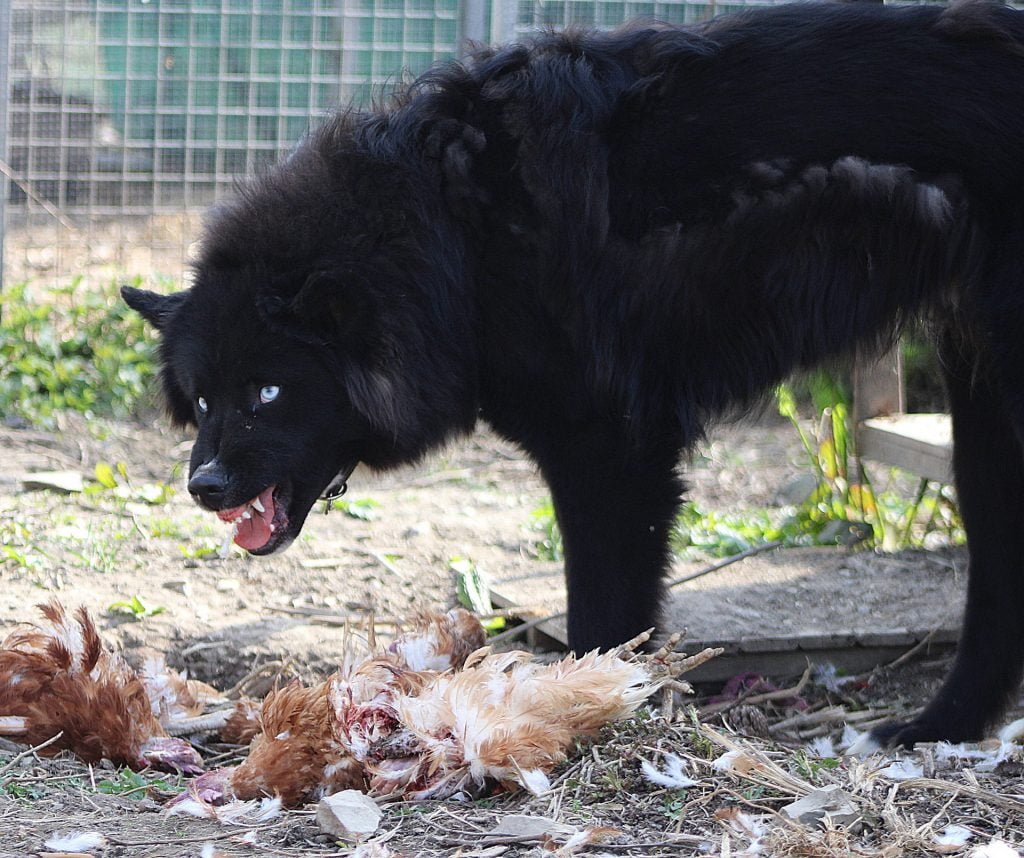
How They Harm Ducks:
- Chasing and Stress: Dogs may chase ducks relentlessly, causing severe stress, exhaustion, and injury.
- Biting and Shaking: A dog bite can cause serious injury or death. Some dogs may shake ducks, leading to broken bones or internal injuries.
- Tearing Feathers: Even if the dog doesn’t intend to kill, grabbing and pulling feathers can cause the duck pain, injury, or stress.
Signs of an Attack:
- Feathers Scattered: If a dog has attacked, you might find clumps of feathers around the area.
- Bite Marks or Wounds: Look for puncture wounds or bite marks on the duck’s body.
- Trampled Ground: Signs of a struggle, such as disturbed ground or flattened grass, can indicate a dog attack.
- Missing Ducks: If a duck is missing, a dog may have chased it away or carried it off.
Prevention and Safety Measures:
- Secure Fencing: Use strong, tall, and buried fencing so that dogs cannot dig under or jump over. Consider adding an electric wire along the bottom to deter digging.
- Supervised Interactions: If you have pet dogs, always supervise their interactions with your ducks. Train your dog to avoid the duck area.
- Physical Barriers: Keep ducks in enclosed pens, especially when you are not around, to prevent dogs from getting close.
- Proper Introductions: Gradually introduce your dogs to the ducks in a controlled manner, rewarding calm behavior to reduce the likelihood of an attack.
- Neighborhood Awareness: Talk to neighbors about keeping their dogs contained. Inform them about the presence of your ducks to avoid accidental harm.
2. Foxes as Duck Predators
You may have heard of the children’s song ‘Fuchs, du hast die Gans gestohlen’ (Fox you stole the goose). Guess what? They also love ducks! They make a good meal for them. They also don’t mind their eggs. Foxes carry the birds to their den and sometimes bury some of them to eat later.
Once a fox knows about your ducks, it will return night after night until they’re all gone. Thus, a determined fox is a very bad predator to have.
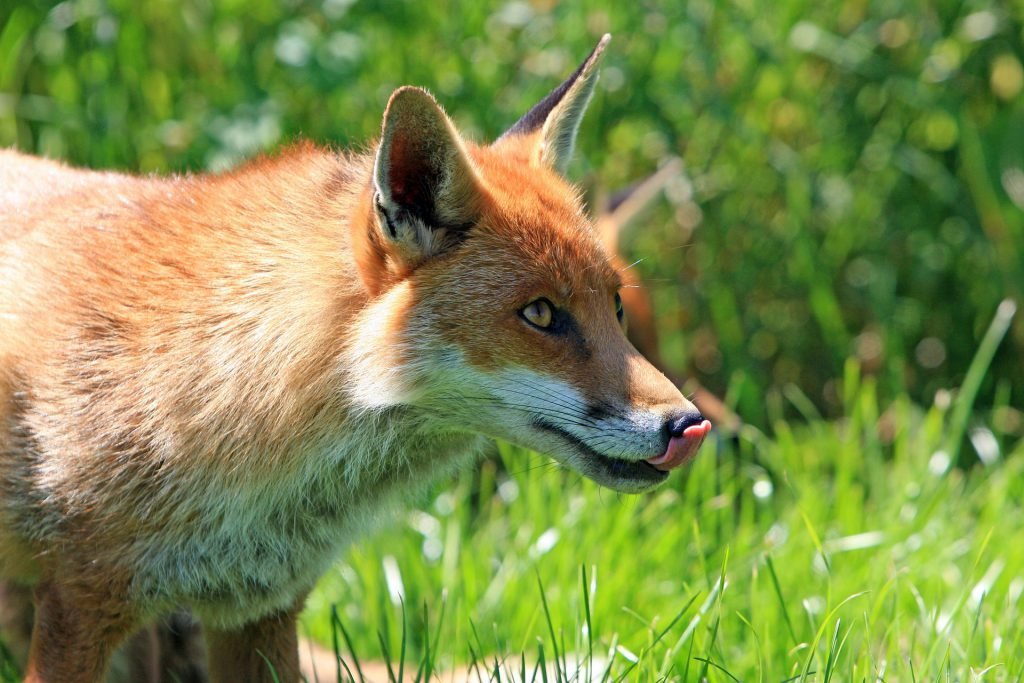
Foxes are very smart and can easily find their way into a coop by digging under fences, squeezing through small holes, and busting through the wire mesh. Since foxes (and the other canine predators) are good diggers, you should consider that when planning and building the coop. Burying hardware cloth skirts around the coop is a standard solution for that.
The signs of a fox in the coop are indicated by blood, bloody feathers, and possibly paw prints. There may also be a lingering smell. Foxes can hunt during the day and at night but are most active at night.
Foxes have also been known to abduct ducks that are out free-ranging, never to be seen again. Foxes are so sly that you may not even see evidence that they took your duck. You may even think they were scooped by a bird of prey instead.
How They Harm Ducks:
- Stealthy Predators: Foxes are clever and stealthy, often sneaking into duck enclosures unnoticed, especially at night.
- Killing for Food: Foxes usually kill ducks by biting their necks, often carrying them away to eat later.
- Mass Killings: In some cases, foxes may kill multiple ducks in one attack, even if they only take one away, leading to significant losses.
- Injuring Ducks: Ducks that escape a fox attack may still suffer from serious injuries, shock, or stress, leading to potential long-term health issues.
Signs of an Attack:
- Feathers and Blood: You might find feathers scattered around and possibly blood, indicating a struggle.
- Missing Ducks: Ducks are often missing entirely, as foxes typically carry their prey away to eat.
- Burrows or Digging: Foxes may dig under fencing to access duck enclosures. Look for signs of digging near the perimeter.
- Tracks and Droppings: Fox tracks are distinctive, showing four toes and a pad, and you may also find fox droppings near the scene.
Prevention and Safety Measures:
- Reinforced Fencing: Use heavy-duty, buried fencing to prevent foxes from digging under. Consider an electric wire around the perimeter to deter digging and climbing.
- Locking Up at Night: Secure ducks in a well-built, locked coop or duck house at night, when foxes are most active.
- Fox-Proof Enclosures: Ensure enclosures have a roof or secure netting, as foxes can jump and climb. Consider adding a skirt around the fence to prevent digging.
- Motion-Sensor Lights or Alarms: Install motion-activated lights or alarms around your duck area to scare off foxes at night.
- Regular Patrols: Check your property regularly for signs of fox activity, such as tracks or burrows, and take action if you spot any.
3. Coyotes as Duck Predators
Coyotes are widespread across North America. Coyotes are equally as common in cities as they are in rural areas. Sometimes, you will find them living under decks and porches. They’re most active at night; you might even hear them yipping and yowling.
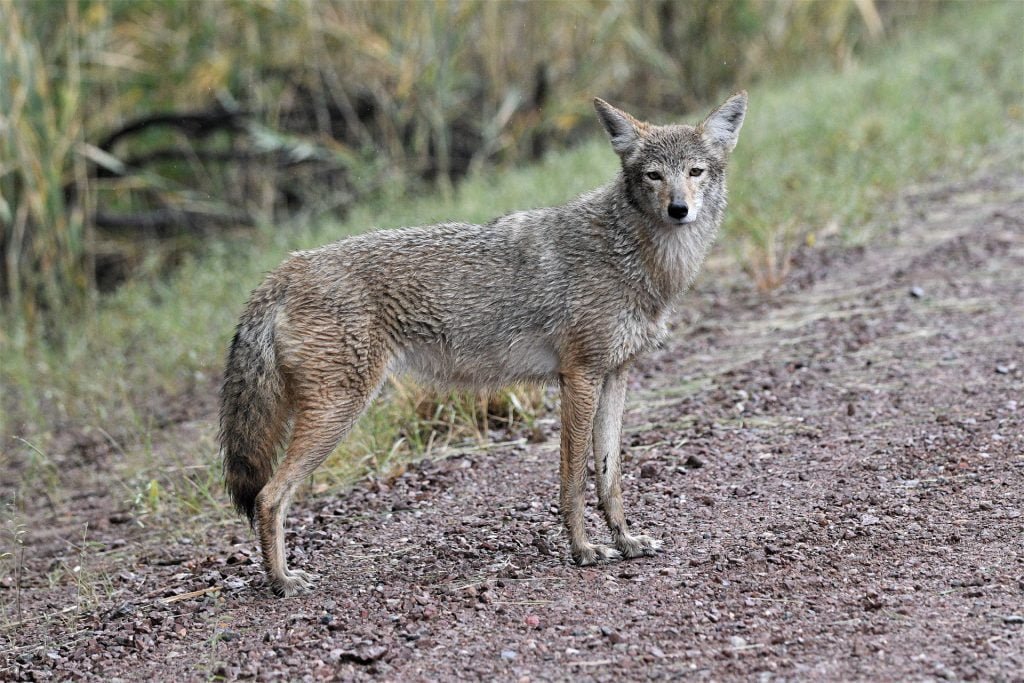
Coyotes usually carry off the birds and are both avid diggers and jumpers. A coyote has a jump height of over six feet. Coyote attacks in duck coops are very much the same as the foxes: scattered feathers, blood, bloody feathers, and possibly paw prints.
Generally, Coyotes will not bother to attack a coop or secure area. Instead, they prefer to go after free-range ducks and carry them off.
How They Harm Ducks:
- Opportunistic Hunters: Coyotes are highly adaptable predators that can target ducks when other food sources are scarce.
- Powerful Attack: Coyotes typically kill ducks by grabbing them by the neck or body, often causing quick death through suffocation or severe injury.
- Carrying Prey Away: Like foxes, coyotes often carry their prey away from the scene to consume it elsewhere, leading to missing ducks.
- Persistent Predators: Coyotes are persistent and may return to the same location repeatedly if they have had success, leading to multiple attacks.
Signs of an Attack:
- Scattered Feathers and Blood: Evidence of a struggle, such as feathers and blood, may be found near the attack site.
- Tracks: Coyote tracks resemble those of dogs but are narrower and more elongated, with visible claw marks.
- Missing Ducks: Often, ducks will simply be missing, as coyotes carry them away after killing them.
- Howling and Yipping: If you hear coyote howls or yips, especially at night, it could be a sign that they are nearby and possibly targeting your ducks.
Prevention and Safety Measures:
- Heavy-Duty Fencing: Use tall, reinforced fencing, ideally with a height of at least 6 feet, to keep coyotes out. Ensure the fence is buried to prevent digging underneath.
- Secure Nighttime Housing: Always lock ducks in a sturdy, secure coop at night, as coyotes are primarily nocturnal hunters.
- Coyote-Proof Enclosures: Consider adding an electric wire along the top and bottom of your fence to deter climbing and digging. Enclosures should be fully enclosed, including the roof, to prevent any access.
- Motion-Activated Lights and Alarms: Install motion-activated lights, alarms, or sprinklers around your duck area to startle and scare off coyotes.
- Remove Attractants: Keep the area around your duck enclosure free of food scraps, pet food, or other attractants that could draw coyotes closer.
- Regular Monitoring: Check for signs of coyote presence, such as tracks or scat, and take action immediately if you notice them in your area.
4. Wolves as Duck Predators
The wolf is a large canine native to Eurasia and North America. Wolves are the big brothers of coyotes and are not that widespread in the cities. However, because they are larger and stronger, they are far more dangerous, not only to your birds but also to you.
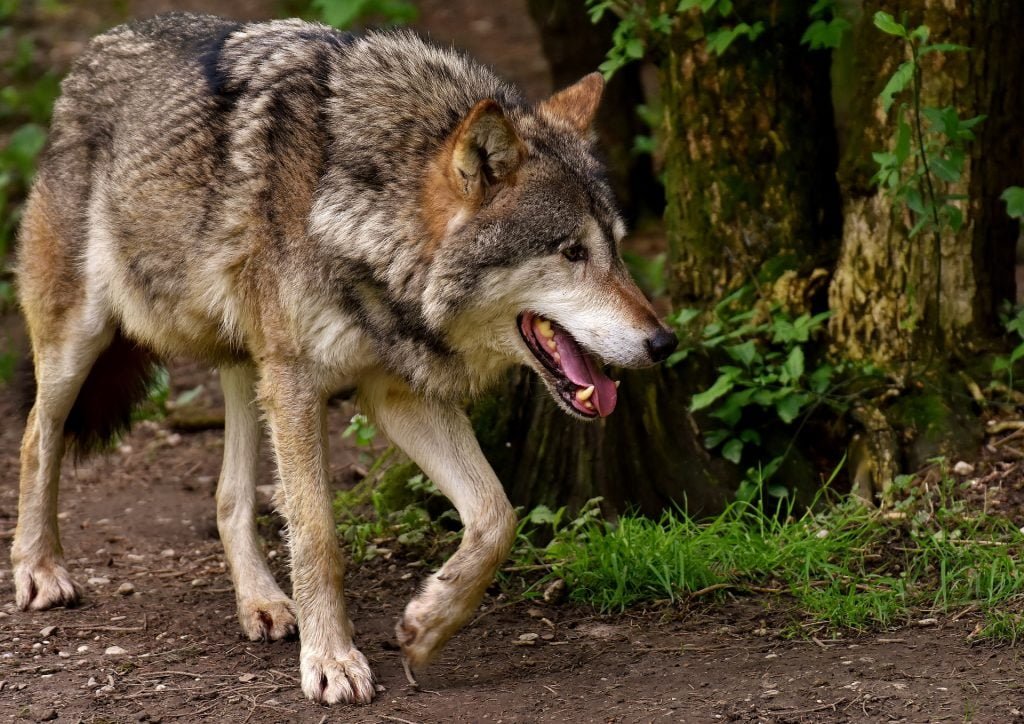
How They Harm Ducks:
- Powerful Hunters: Wolves are large and strong predators capable of easily killing ducks by biting, often with a single lethal bite to the neck or body.
- Hunting in Packs: Wolves may hunt in packs, which can lead to multiple ducks being killed in a single attack, although they usually target larger prey.
- Carrying Prey Away: Wolves, like other predators, may carry ducks away from the attack site to consume them elsewhere, leading to missing ducks.
- Secondary Threat: While wolves primarily target larger animals, they may kill ducks if they are easily accessible or if food is scarce.
Signs of an Attack:
- Large Tracks: Wolf tracks are much larger than dog tracks, with a broad pad and visible claw marks. You may find these near the attack site.
- Feathers and Blood: Evidence of a struggle, such as scattered feathers, blood, or torn ground, may be present.
- Missing Ducks: Similar to other predators, you may find that ducks are missing entirely after a wolf attack.
- Howling: Wolves are known for their howls, which can be heard over long distances, often indicating their presence in the area.
Prevention and Safety Measures:
- Robust Fencing: Use tall, heavy-duty fencing (at least 8 feet high) with a buried base to prevent wolves from jumping over or digging under. Electrified fencing can provide an additional deterrent.
- Secure Night Housing: Ensure ducks are locked up securely at night in a well-built, wolf-proof coop or shelter.
- Full Enclosure: Enclose the entire duck area, including the roof, to prevent wolves from accessing your ducks from above or the sides.
- Guard Animals: Consider using guard animals such as livestock guardian dogs or donkeys, which can deter wolves from approaching.
- Motion-Activated Devices: Install motion-activated lights, alarms, or sprinklers to scare off wolves if they approach the duck area.
- Community Awareness: If you live in an area with a known wolf population, work with neighbors and local wildlife agencies to monitor and manage wolf activity.
5. Bears as Duck Predators
Bears are carnivoran mammals of the family Ursidae. Interestingly, they are classified as doglike carnivorans. There are eight species of bears, and they are widespread, appearing in a wide variety of habitats and are found on the continents of North America, South America, Europe, and Asia.

Baers are very strong and dangerous animals. Don’t try to mess with them. They can easily destroy your duck coop with their strong paws. They can also easily tear down fences and are excellent climbers.
The best way to defend your flock is by not giving a bear a reason to visit you in the first place. Bears are usually attracted by the smell, so you need to keep your feed in secure containers and not keep garbage close to your coop.
If you happen to live in an area with a bear population, an electric fence may be something to consider.
How They Harm Ducks:
- Sheer Strength: Bears are powerful predators capable of breaking into enclosures and killing ducks with a single swipe or bite.
- Destruction of Habitat: Bears may cause significant damage to duck enclosures, tearing down fences, breaking doors, or ripping off roofs to get to the ducks.
- Feeding Behavior: Bears are opportunistic and may kill ducks for food, consuming the entire bird or parts of it, and may return if they find the area to be a reliable food source.
Signs of an Attack:
- Large Claw and Bite Marks: Look for deep gouges or bites on enclosures, feeders, or even on the ground, which indicate a bear attack.
- Broken or Uprooted Fencing: Bears are strong enough to break or lift fencing, leaving it damaged or entirely destroyed.
- Scattered Feathers and Carcasses: Bears may leave behind remains, such as feathers, bones, or partially eaten ducks.
- Bear Tracks: Large, wide tracks with five toes and visible claws are a clear sign of bear activity near your ducks.
Prevention and Safety Measures:
- Heavy-Duty Enclosures: Build your duck enclosures with reinforced materials, including heavy-gauge wire mesh and solid walls, to withstand a bear’s strength. Enclosures should be fully secured, including the roof.
- Electric Fencing: Consider installing electric fencing around the perimeter of the duck area. The shock can deter bears from attempting to enter.
- Secure Nighttime Housing: At night, lock ducks in a sturdy, bear-proof shelter, ideally with reinforced doors and locks.
- Remove Attractants: Keep the area free of food scraps, garbage, or anything that might attract bears. Store feed in bear-proof containers.
- Bear Deterrents: Place bear-deterrents such as motion-activated lights, alarms, or bear spray canisters around the enclosure.
- Community Coordination: If bears are known in your area, coordinate with neighbors and local wildlife authorities to keep everyone informed and take collective action if needed.
Feline Duck Predators
6. Cats as Duck Predators
Many cats are strolling around through the neighborhood and may visit your property. While cats are probably less of a threat than dogs, they can still injure your ducks if they choose violence. Cats are probably afraid of adult ducks but may want to defend themselves if they feel threatened. But if you have ducklings, cats might be very interested in them. It could be that they want to play with them (which can cause injuries), or they may think that they are a nice small snack for them.

How They Harm Ducks:
- Targeting Ducklings: Due to size differences, cats are more likely to prey on ducklings or small bantam ducks than on adult ducks.
- Quick and Stealthy Attacks: Cats are stealthy hunters who can quickly pounce on ducklings, causing fatal injuries through biting or clawing.
- Playing with Prey: Some cats may “play” with their prey, which can lead to prolonged stress, injury, or death for ducklings.
Signs of an Attack:
- Small Bite or Claw Marks: Look for small puncture wounds, typically on the neck or body, or scratches on the ducklings.
- Feathers Scattered: If a cat has attacked, you may find a small pile of feathers, often with little blood, as cats tend to be tidy hunters.
- Missing Ducklings: Ducklings may go missing entirely if a cat carries them off.
- Cat Tracks: Small, round paw prints with no visible claw marks (since cats retract their claws) might be found near the scene.
Prevention and Safety Measures:
- Secure Brooding Areas: Ensure that ducklings are kept in a secure, enclosed brooder or pen, preferably indoors or within a predator-proof area that cats cannot access.
- Supervise Free-Range Time: When letting ducklings or small ducks roam, supervise them closely, especially if there are outdoor cats in the area.
- Cat-Proof Fencing: Install fine mesh or hardware cloth around the brooder or duckling pen to prevent cats from squeezing through gaps.
- Keep Cats Indoors: If you own cats, keep them indoors, especially during the ducklings’ most vulnerable stages.
- Neighborhood Awareness: Inform neighbors with outdoor cats about your ducks, and ask them to monitor their pets or take preventive measures to avoid accidental harm.
7. Bobcats
The bobcat (Lynx rufus), also known as the red lynx, is a medium-sized cat native to North America. The bobcat can survive for long periods without food but eats heavily when prey is abundant. This is why they will come back until all your ducks are gone.
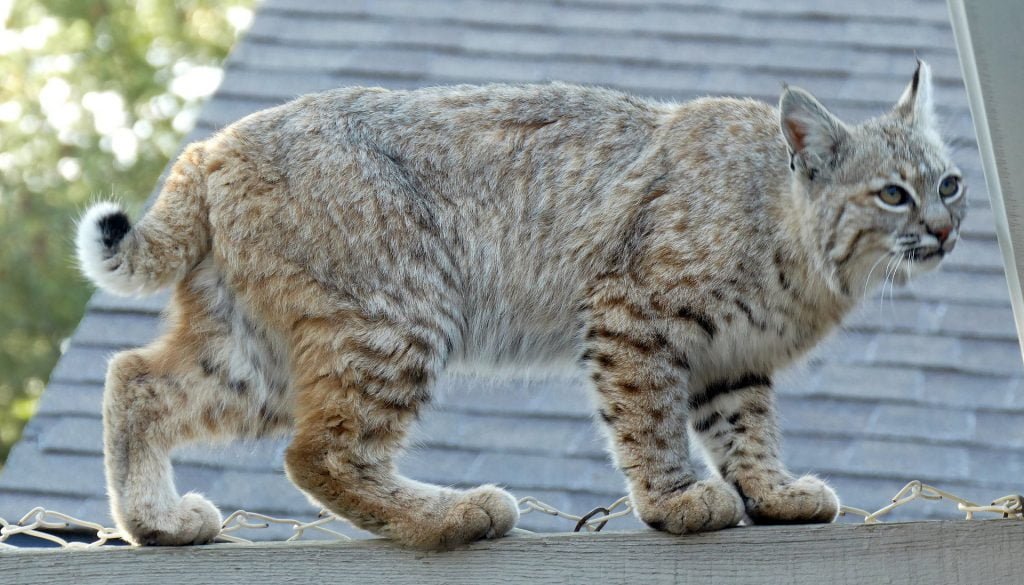
Big Cats also carry off the birds, but they cover them with sticks, leaves, and dirt just like they would cover them with litter. If one of these cats got in your coop, you will see signs of scratch marks around the area where they killed the bird. The good news is that they do not dig like foxes and coyotes. Therefore, they can jump pretty well and will climb on the coop. Make sure the coop is sturdy and also has a solid roof. It is also advised to use 1/4 inch hardware cloth that they cannot reach inside with their paws.
How They Harm Ducks:
- Stealthy and Skilled Hunters: Bobcats are solitary, stealthy predators that can easily sneak up on ducks, especially at night or during dawn and dusk.
- Quick and Lethal Attack: Bobcats kill ducks with a powerful bite to the neck or head, often causing instant death.
- Carrying Prey Away: After killing, bobcats may carry ducks away to a secluded area to eat, leading to missing ducks.
Signs of an Attack:
- Distinctive Bite Marks: Bobcats typically leave bite marks on the neck or head of ducks that are larger and deeper than those from domestic cats.
- Feathers in a Trail: You may find a trail of feathers leading away from the attack site, as bobcats often drag their prey to a safe spot.
- Claw Marks: Bobcats may leave claw marks on the ground, fence posts, or trees near the attack site as they attempt to gain access or carry prey away.
- Bobcat Tracks: Look for paw prints with four toes and no visible claws (bobcats retract their claws). Their tracks are larger than those of domestic cats and more rounded.
Prevention and Safety Measures:
- Robust Enclosures: To prevent bobcats from accessing ducks, use strong, fully enclosed pens or coops with a solid roof. Reinforce doors and windows with heavy-duty locks and materials.
- High Fencing: Install tall fencing (at least 6 to 8 feet) around the duck area. Consider using an angled top or adding an electric wire to deter bobcats from climbing over.
- Secure Night Housing: Always lock ducks in a secure, well-built coop or shelter at night, as bobcats are most active during the twilight hours.
- Motion-Activated Deterrents: Use motion-activated lights, alarms, or sprinklers around the duck area to scare off bobcats before they get too close.
- Clear Vegetation: Keep the area around your duck enclosure clear of dense vegetation or debris that could provide hiding spots for bobcats.
- Monitor and Report: If you live in an area with bobcats, regularly monitor for signs of their presence, and report sightings to local wildlife authorities.
We have bobcats in our area, and we caught one on camera trying to get into our duck coop. Luckily, it was sturdy enough, and our ducks stayed safe. See for yourself how scared our ducks were:
8. Cougars as Duck Predators
The cougar (Puma concolor) is a large cat native to the Americas and has many common names, including puma, mountain lion, catamount, and panther. Its range spans from the Canadian Yukon to the southern Andes in South America and is the most widespread of any large wild terrestrial mammal in the Western Hemisphere.
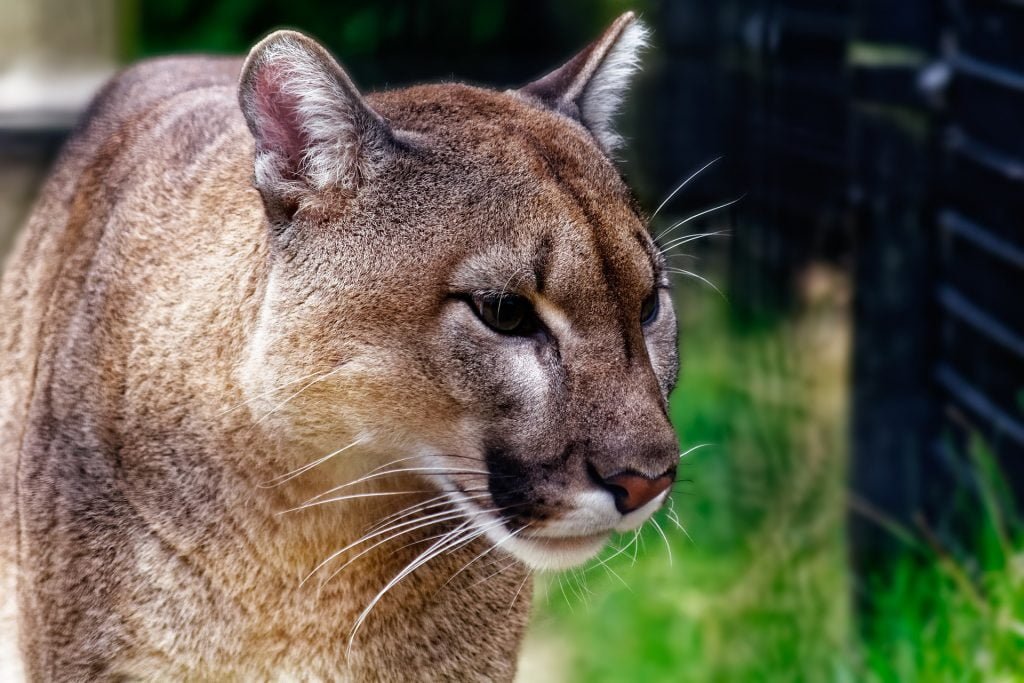
The cougar is a generalist, a hypercarnivore. It prefers large mammals such as mule deer, white-tailed deer, elk, moose, mountain goats, and bighorn sheep. However, it will opportunistically take smaller prey, such as ducks. Since it is larger than bobcats, it is also far more dangerous.
How They Harm Ducks:
- Powerful Predators: Cougars, also known as mountain lions or pumas, are large and powerful predators that can easily kill ducks with a single bite or swipe.
- Silent and Stealthy: Cougars are known for their stealth. They often stalk prey silently before launching a quick and deadly attack.
- Carrying Prey Away: After killing, cougars may carry their prey, including ducks, to a secluded area to eat, leading to missing ducks.
Signs of an Attack:
- Large Bite Marks: Cougars typically kill ducks by biting the neck or head, leaving large, deep puncture wounds.
- Scattered Feathers and Remains: You may find feathers scattered around, or in some cases, the remains of the duck if the cougar did not carry it away.
- Drag Marks: Look for drag marks in the dirt or grass where the cougar may have carried the duck away.
- Cougar Tracks: Cougar tracks are large, with four toes and no visible claws (since cougars retract their claws). Their tracks are round and larger than those of bobcats.
Prevention and Safety Measures:
- Heavy-Duty Enclosures: Use strong, reinforced enclosures for your ducks, with solid walls and a roof to prevent cougars from jumping in. Ensure all entry points are securely locked and reinforced.
- High and Sturdy Fencing: Install fencing at least 10 to 12 feet high around the duck area. Consider adding an overhang or electric wire to deter cougars from climbing over.
- Secure Nighttime Shelter: Always lock ducks in a well-constructed, secure shelter at night, as cougars are most active during dusk and dawn.
- Motion-Activated Deterrents: Install motion-activated lights, alarms, or sprinklers around your duck enclosure to scare off cougars before they approach.
- Clear Surroundings: Keep the area around your duck enclosure clear of dense vegetation, trees, or debris that could provide cover for a stalking cougar.
- Community Awareness: If you live in cougar territory, work with neighbors and local wildlife authorities to monitor and manage cougar activity, sharing any sightings or signs of their presence.
Other Mammals as Duck Predators
9. Raccoons as Duck Predators
The raccoon (Procyon lotor) is a mammal native to North America.
Raccoons are incredibly smart, intelligent, and resourceful. They look very lovable and cuddly, but these striped bandits are fierce and adaptable predators. Raccoons are wily creatures and will tag team with one of the raccoons scaring the birds to one side of the coop or running where another coon is waiting to scoop them up.

They also can pull out staples, open windows, and unlatch doors. Raccoons kill and eat the birds right in the coop or run. Signs of raccoons include puncture marks on the head and partially consumed birds. Other signs are that only the head and crop are eaten, the ducks are pulled through fencing and are partially eaten, there are empty eggshells in the coop, a faint musky odor, and roughly 5-7 nights between each attack.
You should use 1/4 inch hardware cloth instead of chicken wire to protect your flock. It is also advised to use more complex locks, as raccoons can easily open simple latches.
How They Harm Ducks:
- Clever and Dexterous: Raccoons are highly intelligent and can use their dexterous paws to open latches and doors or even reach through fencing to grab ducks.
- Nocturnal Predators: They usually strike at night, targeting ducklings or smaller ducks and often killing them by biting their necks or heads.
- Partial Predation: Raccoons may not always carry their prey away, sometimes consuming only parts of the duck and leaving the rest behind.
Signs of an Attack:
- Mangled or Missing Ducks: Ducks may be found with bite marks, particularly around the neck, or they may have been partially eaten or missing entirely.
- Scattered Feathers and Blood: Evidence of a struggle, such as scattered feathers or blood around the coop, is common.
- Tracks and Droppings: Raccoon tracks show five distinct toes and look like small handprints. You may also find droppings near the attack site.
- Damaged Enclosures: If a raccoon has been at work, you may find broken latches, open doors, or holes in the fencing where they tried to reach.
Prevention and Safety Measures:
- Secure Enclosures: Ensure that your duck enclosures are raccoon-proof by using heavy-duty locks and latches that raccoons cannot easily manipulate. Hardware cloth with a fine mesh (no larger than 1/2 inch) should be used to cover any openings, including ventilation holes.
- Lock Ducks Up at Night: Always lock ducks in a secure coop at night, making sure doors and windows are firmly closed and latched.
- Bury Fencing: If using fencing, bury it at least 12 inches underground to prevent raccoons from digging underneath to gain access.
- Remove Attractants: Keep the area around your duck enclosure clean and free of food scraps, garbage, or unsecured pet food that might attract raccoons.
- Motion-Activated Lights: Installing motion-activated lights or sprinklers can startle and deter raccoons from approaching the duck area.
- Regular Inspections: Frequently inspect the enclosure for signs of attempted entry or weakness in the structure, and reinforce as needed.
10. Skunks as Duck Predators
Skunks are mammals known for their ability to spray a liquid with a strong, unpleasant scent from their anal glands. They are primarily found in the Americas.
Skunks are opportunists, and as such, they do not stalk ducks. Skunks are far more likely to eat eggs and ducklings. If skunks are desperate, they certainly will kill and eat ducks, generally going for the bird’s throat. Keeping your coop locked and secure will prevent skunks from attacking your flock. Key signs include stolen eggs, dead ducklings, and a faint stunk odor.
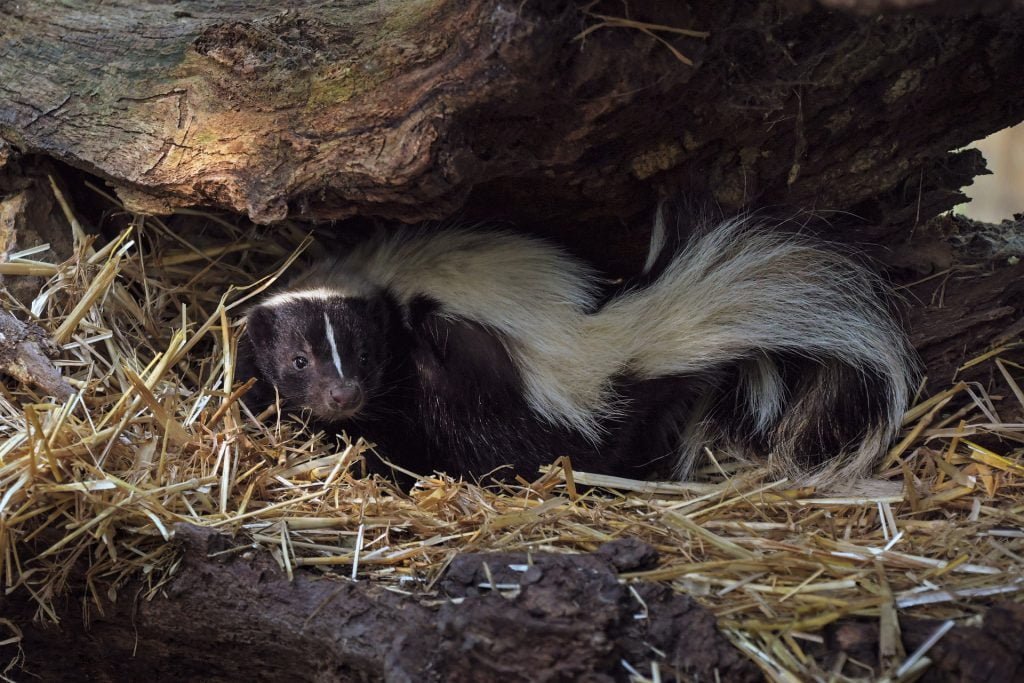
How They Harm Ducks:
- Opportunistic Feeders: Skunks are opportunistic omnivores and may prey on ducks, particularly ducklings, when other food sources are scarce.
- Nighttime Attacks: They are primarily nocturnal and can attack at night, often targeting vulnerable ducklings or injured ducks.
- Clawing and Biting: Skunks typically use their claws and teeth to attack, causing injuries that can be fatal.
Signs of an Attack:
- Small Bite and Scratch Marks: Look for small puncture wounds or scratches, usually around the neck or body.
- Feathers and Scattered Remains: Feathers may be scattered around, with some parts of the duck left behind.
- Skunk Tracks: Skunk tracks are small, with five toes and no visible claws. They are often round and about the size of a small fist.
- Odor: Skunks are known for their distinctive smell. If you notice a strong, unpleasant odor around the duck area, it may indicate a skunk has been nearby.
Prevention and Safety Measures:
- Secure Enclosures: Use strong, fine mesh fencing (no larger than 1/2 inch) around duck enclosures to prevent skunks from squeezing through or reaching inside.
- Lock Ducks Up at Night: Always lock ducks in a secure coop or shelter at night, ensuring all entry points are tightly closed and reinforced.
- Bury Fencing: Bury the base of the fence at least 12 inches underground to prevent skunks from digging under to access the ducks.
- Remove Attractants: Keep the area around your duck enclosure clean and free of food scraps, garbage, or other attractants that might draw skunks.
- Motion-Activated Deterrents: Install motion-activated lights, alarms, or sprinklers to deter skunks from approaching your ducks.
- Regular Inspections: Check for any signs of attempted entry or damage to the enclosure and repair any weaknesses immediately.
11. Weasels as Duck Predators
Weasels are small carnivores with very elongated, slender bodies. Most of them live in the Northern Hemisphere and belong to the Mustela genus. In addition to weasels, another 17 species of ferrets and polecats, as well as the mink and the ermine, belong to the family of Mustelidae. Along with their tubelike bodies, weasels have small, flattened heads, long, flexible necks, and short limbs, which makes it easy for them to get through small openings and, thus, into duck coops.
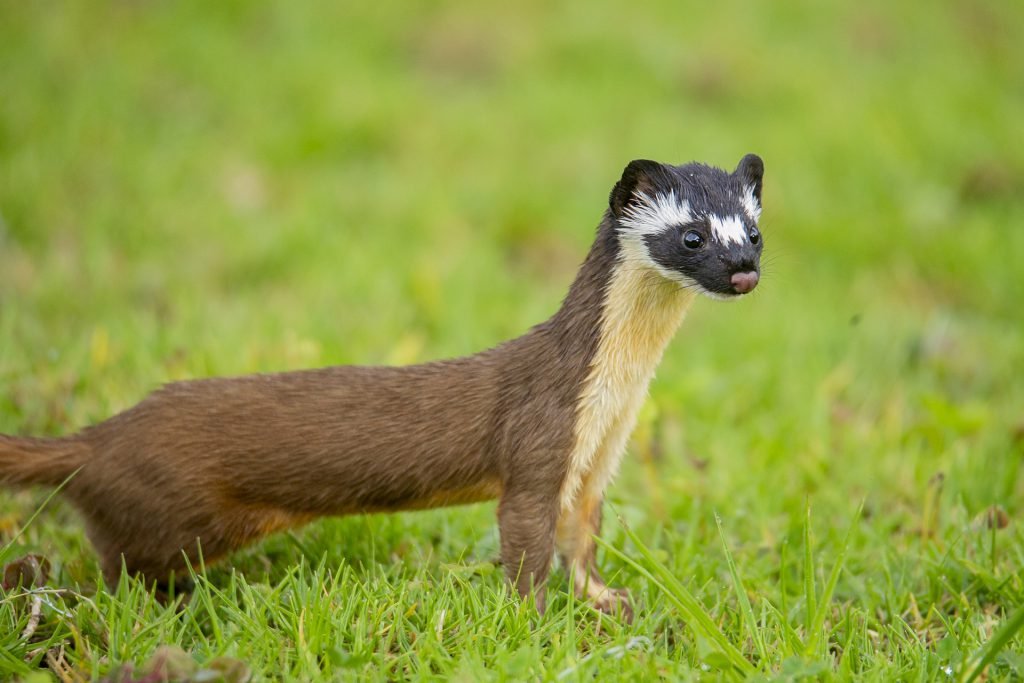
Minks and weasels are notorious for killing for fun. They’ll often kill birds and leave them dead in the coop, then kill another. They can access tiny spaces, such as 1.5-inch holes, and will kill far more ducks than they need for food. It might be a weasel if your bird has been killed but is still intact. Or if your duck’s intestines have been pulled out, then there is a high probability that a weasel has also attacked your flock.
How They Harm Ducks:
- Small but Deadly: Weasels are small, agile predators that can be surprisingly lethal to ducklings or small ducks. They typically kill by attacking the neck or head.
- Quick and Stealthy Attacks: They are stealthy and quick, often attacking at night or early morning, when ducks are least alert.
- Multiple Victims: Weasels may kill multiple ducks in one attack, often biting the neck and leaving the bodies behind or consuming just parts of the ducks.
Signs of an Attack:
- Small Puncture Wounds: Look for tiny puncture wounds around the neck or head of the ducks.
- Scattered Feathers: Feathers may be found scattered around, often with little blood if the attack was quick.
- Weasel Tracks: Weasel tracks are small, with five toes and no visible claws. They are similar in size to a domestic cat’s tracks but more rounded and compact.
- Burrows or Holes: Weasels may create small burrows or use existing holes to enter enclosures. Look for small, narrow entrances near the enclosure.
Prevention and Safety Measures:
- Fine-Mesh Fencing: Use fine mesh fencing (no larger than 1/2 inch) around the duck enclosure to prevent weasels from squeezing through or reaching inside.
- Secure Enclosures: Ensure that the duck coop or shelter is tightly closed and reinforced, with no gaps or weak points where weasels could enter.
- Bury Fencing: Bury the bottom of the fence at least 12 inches underground to prevent weasels from digging underneath.
- Remove Attractants: Keep the area around your duck enclosure clean and free of food scraps, garbage, or other attractants that might lure weasels.
- Regular Inspections: Frequently check for signs of attempted entry, such as small burrows or holes near the enclosure, and reinforce any weak areas.
- Trapping: If weasels are a known problem in the area, consider using humane traps to catch and relocate them away from your property.
12. Opossums
Opossums are members of the marsupial order Didelphimorphia, endemic to the Americas. The most significant order of marsupials in the Western Hemisphere comprises 93 species in 18 genera. The Virginia opossum is the only species found in the United States and Canada. It is often simply referred to as an opossum or just as a possum. Although all living opossums are essentially opportunistic omnivores, different species vary in the amount of meat and vegetation they include in their diet.

Opossums are relatively lazy and rarely attack grown and healthy birds. However, they will happily eat the eggs and ducklings if they can access them. They may also eat the duck food, so make sure to take it away during the night and collect your eggs every morning not to give them any reason to snoop around the coop. Keep the coop closed to protect your flock, especially when you have ducklings around. You can tell that an opossum raided your coop when you find mashed eggs. Possums are messy eaters that tend to chew the shells into small pieces and leave them in the nest.
How They Harm Ducks:
- Opportunistic Feeders: Opossums are opportunistic omnivores and may prey on ducks, particularly ducklings or weaker ducks if other food sources are scarce.
- Nighttime Activity: They are primarily nocturnal and may attack ducks at night, often targeting those that are not securely housed.
- Clawing and Biting: Opossums use their claws and teeth to attack, typically causing injuries that can be fatal to ducks.
Signs of an Attack:
- Small Bite and Scratch Marks: Look for small puncture wounds or scratches, usually around the ducks’ necks or bodies.
- Feathers and Scattered Remains: Evidence of a struggle may include scattered feathers, blood, or partially eaten ducks.
- Opossum Tracks: Opossum tracks are oval-shaped with five toes. They may also leave distinctive drag marks if they attempt to carry off a duck.
- Feces: Opossum droppings are often found near the scene of the attack. They are typically tubular and may contain visible bones or seeds.
Prevention and Safety Measures:
- Secure Enclosures: Use strong, fine mesh fencing (no larger than 1/2 inch) to prevent opossums from squeezing through or reaching inside the duck area. Ensure that all entry points are securely closed and reinforced.
- Lock Ducks Up at Night: At night, always lock ducks in a secure coop or shelter, ensuring all doors and windows are tightly closed and latched.
- Bury Fencing: Bury the base of the fencing at least 12 inches underground to prevent opossums from digging underneath to access the ducks.
- Remove Attractants: Keep the area around your duck enclosure clean and free of food scraps, garbage, or other attractants that might lure opossums.
- Motion-Activated Deterrents: Use motion-activated lights, alarms, or sprinklers to deter opossums from approaching your ducks.
- Regular Inspections: Frequently inspect the enclosure for signs of attempted entry or damage and reinforce any weak spots immediately.
Birds of Prey
13. Hawks, Eagles, and Falcons as Duck Predators
There are over 23 species of hawks in North America; common species include Red-Tailed Hawks, Coopers Hawks, Eagles, Kites, and Harriers.
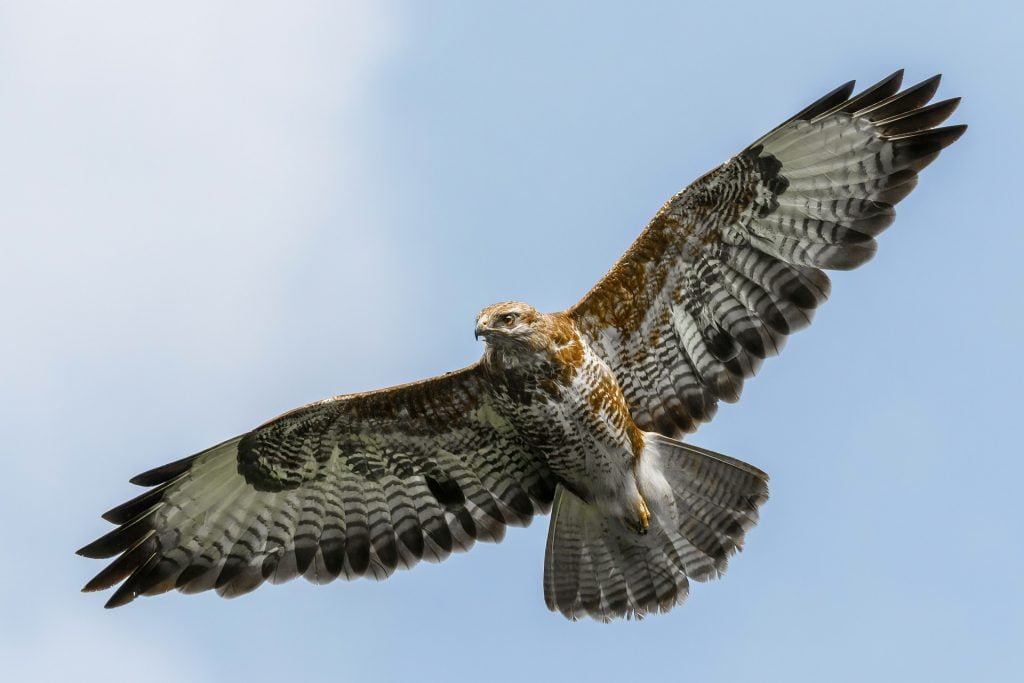
Hawks are common predators for ducks, especially when your flock is free-ranging. Many species have adapted well to the urban landscape and can be seen in towns and cities. Hawks have excellent eyesight and can spot their prey from as far as two miles away. Hawks will only kill to survive, not for fun like other predators, such as the raccoon.
Hawks prefer to hunt during the day in open fields, which makes it easier for them to pick up their prey. This is why your ducks are especially vulnerable when they are free-ranging in a yard with no trees or bushes to hide. But when hungry, they will also attack in less open environments.
Hawks are deadly birds known for killing rodents and other prey animals such as ducks and chickens. Once they’ve spotted a duck, they will swoop down and grab it with their powerful talons before they bring it to a safe place to eat. And they are fast! You will rarely find any signs of predation; your ducks will just disappear.
To protect your ducks from birds of prey, you should either only allow them to free range when supervised (by humans or guard dogs) or install avian netting. Covering the whole area with bird netting is advised because hawks are intelligent and can quickly spot gaps. Some people use scarecrows, reflective items, or owl decoys. This may help for a few days to deter hawks, but they are smart enough to realize soon that these items are no actual threads to them and will try to attack again. You would need to change the locations of these distractors regularly.
How They Harm Ducks:
- Powerful Hunters: Birds of prey, such as hawks, eagles, and falcons, are skilled hunters with keen eyesight and powerful talons. They can swoop down and grab ducks, particularly smaller ducks or ducklings, with lethal precision.
- High-Flying Attacks: They attack from above, often targeting ducks that are in open or less protected areas.
- Sharp Talons and Beaks: Their sharp talons can cause fatal injuries, and their beaks are used to tear flesh.
Signs of an Attack:
- Feathers and Blood: Look for scattered feathers and blood around the area where the duck was attacked. If the bird of prey carried the duck away, there would often be little to no body left.
- Large Bird Tracks: If the predator lands nearby, you may find large, round tracks with three or four talon marks.
- Raptor Droppings: Droppings from birds of prey may contain feathers, bones, or other undigested parts of their prey.
- Perching Marks: Check for signs of birds of prey perching near the duck enclosure, such as droppings or feather marks on fences or nearby trees.
Prevention and Safety Measures:
- Covered Enclosures: Use covered or fully enclosed pens with a solid roof to prevent birds of prey from swooping down and attacking ducks. Netting or wire mesh with small openings can also provide protection.
- Secure Night Housing: Always lock ducks in a secure, fully enclosed shelter at night to protect them from nocturnal birds of prey like owls.
- Decoys and Deterrents: Install decoys of larger birds of prey or use reflective objects to scare away real birds of prey. Some people use fake owls or hawks to deter other raptors.
- Shaded Areas: Provide shaded areas or structures where ducks can hide from potential aerial predators.
- Regular Supervision: Supervise ducks while they are free-ranging, particularly in open areas where they are more vulnerable to attacks from birds of prey.
- Community Awareness: If birds of prey are common in your area, work with local wildlife authorities to understand their behavior and take additional precautions as needed.
14. Owls as Duck Predators
There are over 200 species of owls worldwide. They are nocturnal birds, meaning they hunt in the darkness. They have excellent night vision and binaural hearing. They usually hunt for small mammals, insects, and other birds. Larger species might even attack l larger birds, such as our ducks.
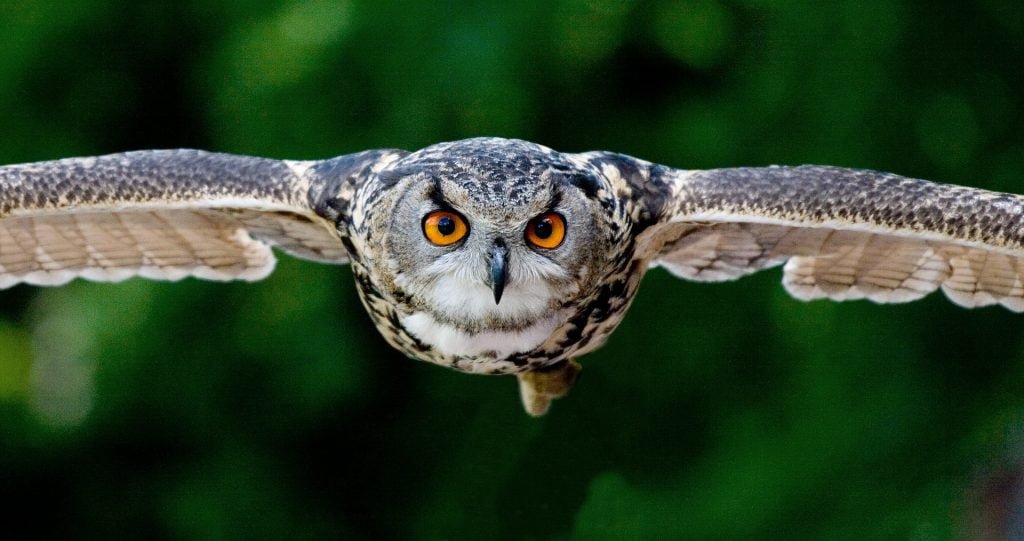
Much of the owls’ hunting strategy depends on stealth and surprise. An owl’s sharp beak and powerful talons allow it to kill its prey before swallowing it whole (if it is not too big). To best protect your flock from owls, you should lock them up before dark inside a covered coop.
How They Harm Ducks:
- Nocturnal Hunters: Owls are primarily nocturnal and hunt during the night. They use their exceptional night vision and silent flight to swoop down on unsuspecting ducks, especially ducklings or weaker individuals.
- Powerful Talons: Owls use their sharp talons to grasp and kill their prey. Their powerful talons can cause fatal injuries and are effective at capturing and carrying off ducks.
- Silent Flight: Their silent flight allows them to approach their prey without detection, making them especially dangerous for ducks that are not securely housed at night.
Signs of an Attack:
- Feathers and Blood: Look for scattered feathers and blood around the area where the attack occurred. Owls often leave behind little evidence other than feathers if they carry their prey away.
- Large Bird Droppings: Owl droppings can contain feathers and bones. They are typically white and chalky with dark, digested parts.
- Talon Marks: You may find distinct talon marks on the ground or on the remaining parts of the duck.
- Pellets: Owls regurgitate indigestible parts of their prey, forming pellets that can be found near the attack site. These pellets often contain feathers, bones, or other undigested material.
Prevention and Safety Measures:
- Covered or Enclosed Pens: Use covered pens or coops with a solid roof to prevent owls from swooping down and attacking ducks. Wire mesh or netting with small openings can also provide protection.
- Secure Night Housing: Always lock ducks in a secure, fully enclosed shelter at night to keep them safe from nocturnal predators like owls.
- Decoys and Deterrents: Use decoys of larger birds of prey or reflective objects to scare away real owls. Some people use fake owls as deterrents, though this may be less effective over time as owls get used to them.
- Shaded Hiding Spots: Provide shaded areas or structures where ducks can seek shelter from aerial predators.
- Regular Monitoring: Supervise ducks when they are free-ranging, particularly in areas where they are more vulnerable to owl attacks.
- Community Awareness: Work with local wildlife authorities to understand owl behavior and take additional precautions as necessary.
Others Duck Predators
15. Snakes as Duck Predators
There are over 3,000 species of snakes, and they are found almost anywhere on this planet. Only about 600 of them are venomous. Most of the non-venomous snakes are (relatively) harmless, with some exceptions, like the python. Depending on where you live, you will have different types of snakes you should know.
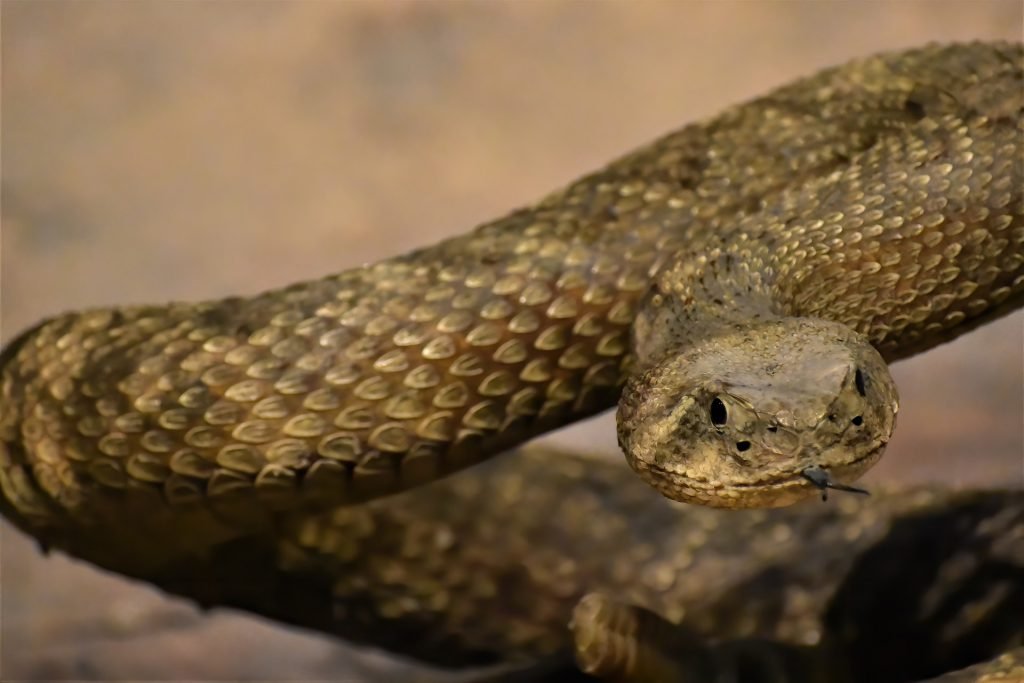
Snakes are primarily interested in eggs and young ducklings (less than four weeks). Snake predation can be hard to identify because snakes can eat an egg whole, so the only sign of intrusion is a missing egg. The aftermath of a snake’s egg-eating activity differs from that of raccoons, skunks, or opossums, which typically leave shells behind after eating eggs.
The size of the hole a snake needs to get into your coop depends on the size of the snake. Typically, snakes can enter through gaps that are 1/4-inch in diameter or smaller and do not cause predation damage. Sometimes, the snakes cannot exit the coop after swallowing their prey because they will no longer fit through the gap. In this case, they may just sleep inside the coop until it is digested enough. I have heard of cases where they feel stressed and threatened by ducks and have attacked them, especially when the ducks try to defend their eggs or ducklings.
Snakes can be beneficial because they are excellent pest control and keep the number of rats and mice in check. Water can easily deter them, so spraying them with a water hose will usually scare them away if they come too close to you or the coop.
How They Harm Ducks:
- Constrictors: Many snakes, such as boas and pythons, are constrictors that can kill ducks by wrapping around them and squeezing until they suffocate.
- Non-Constrictors: Other snakes, like garter snakes, may bite and eat smaller ducklings, particularly if the duckling is weak or injured.
- Swallowing Prey: Some snakes may attempt to swallow a duck whole, particularly smaller ducklings, which can result in injury or death.
Signs of an Attack:
- Missing or Injured Ducklings: Look for signs of missing or injured ducklings, especially if they are small and vulnerable.
- Snake Tracks: Snake tracks are often distinct, with a series of parallel lines or undulating patterns in the dirt or sand. Some snakes may leave noticeable trails through grass or mud.
- Sloughed Skin: Snakes periodically shed their skin. Finding a discarded snake skin near the duck area can indicate the presence of a snake.
- Feather and Blood Evidence: If a duck was attacked, there may be feathers and blood around the area, though this can be less apparent if the snake swallowed the duck whole.
Prevention and Safety Measures:
- Secure Enclosures: Use fine mesh or hardware cloth to cover any openings in the duck enclosure. Ensure that the mesh is small enough to prevent snakes from entering or reaching through.
- Bury Fencing: Bury the base of the fencing at least 12 inches underground to prevent snakes from digging underneath to access the ducks.
- Remove Hiding Spots: Keep the area around the duck enclosure clear of tall grass, piles of debris, or other materials that could provide hiding spots for snakes.
- Regular Inspections: Frequently inspect the enclosure for signs of attempted entry or snake activity and reinforce any weak spots.
- Seal Gaps: Ensure that the enclosure does not have gaps or holes that a snake could use to enter.
- Use Snake Repellents: Some people use snake repellents or natural deterrents, like crushed eggshells or essential oils, to keep snakes away, though effectiveness can vary.
- Professional Help: If you have a persistent snake problem, consider consulting a professional pest control service or wildlife expert for assistance.
16. Snapping Turtles as Duck Predators
Snapping turtles (Chelydra serpentina) are the silent assassins of the pond, masters of ambush with lightning-fast reflexes. Their powerful jaws, lined with razor-sharp teeth, can snap shut with a force of over 100 pounds per square inch – enough to crush a small animal whole. Armed with a long, muscular neck that can strike with surprising speed, they lie in wait for unsuspecting prey, their rough, mossy shells blending seamlessly with the underwater environment.
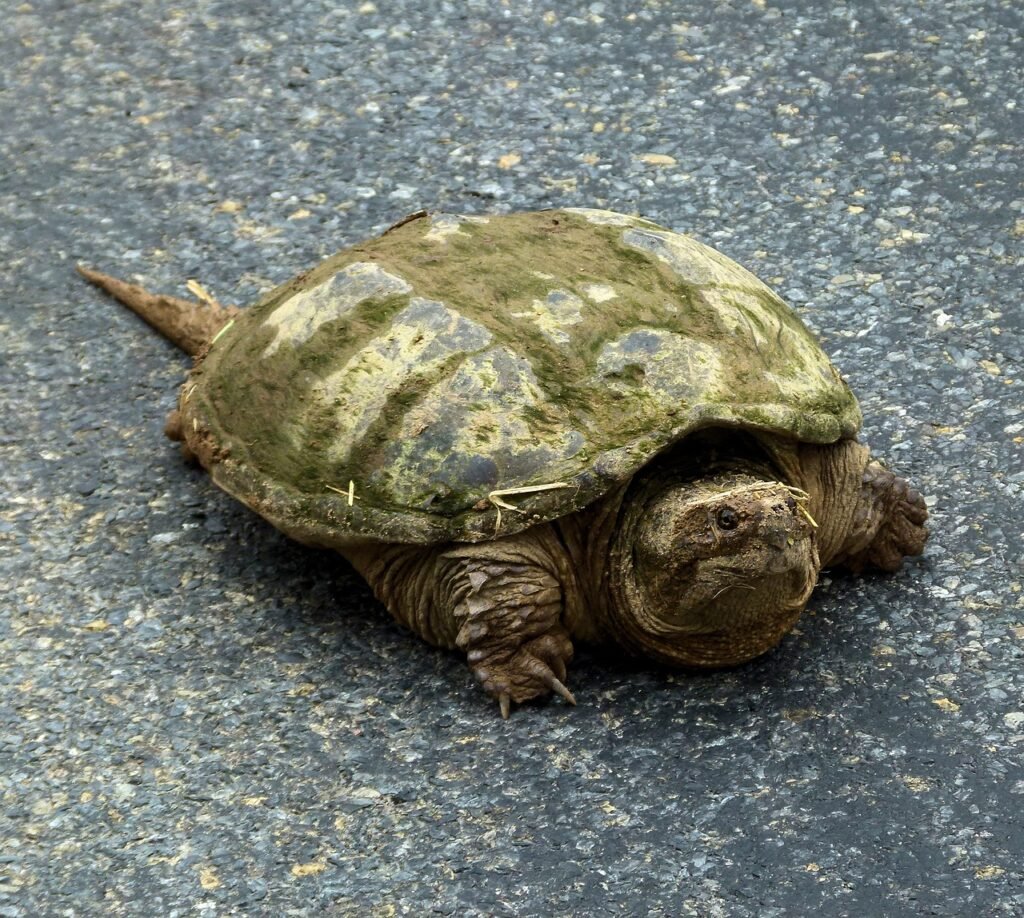
For ducks, snapping turtles pose a serious threat. With their fluffy down and slow swimming skills, ducklings are easy targets. But even adult ducks can fall prey to these opportunistic hunters. Snapping turtles lie in wait, camouflaged against the muck, and lunge quickly when a duck comes within range. Their powerful jaws can crush bones and sever limbs, making them a nightmare for any feathered friend. They can even bite parts of the duck’s beak off.
How They Harm Ducks:
- Powerful Jaws: Snapping turtles have extremely powerful jaws that can deliver a crushing bite. They may attack and kill ducks, particularly ducklings or weak individuals.
- Aquatic Ambush: Snapping turtles are aquatic predators and may ambush ducks when they come close to the water, grabbing them by the legs or neck and dragging them underwater.
- Slow and Steady: While not fast on land, snapping turtles are effective in water and can strike swiftly when their prey is in reach.
Signs of an Attack:
- Missing or Injured Ducklings: Look for missing or injured ducklings, especially if they were near water sources.
- Bite Marks: You may find large bite marks or wounds around the legs or neck of ducks, though snapping turtles may also leave minimal evidence if they drag the duck underwater.
- Shell Fragments: If a snapping turtle was involved, you might find pieces of turtle shell or remnants near the attack site.
- Tracks: Snapping turtle tracks are usually broad and distinct, with a clawed footprint that shows their aquatic nature.
Prevention and Safety Measures:
- Protect Water Sources: If your ducks have access to ponds or other water sources, ensure these are monitored and protected. Consider creating barriers or fences around the water to prevent snapping turtles from getting close.
- Secure Enclosures: Ensure that any duck enclosures near water are securely enclosed with fine mesh or hardware cloth to prevent snapping turtles from reaching through.
- Shallow Water Areas: If possible, keep ducklings away from deep or murky water where snapping turtles are more likely to be present.
- Regular Inspections: Frequently check the perimeter of the duck enclosure and nearby water sources for signs of snapping turtle activity or attempted entry.
- Remove Attractants: Keep the area around water sources clean and free of food scraps or other attractants that might draw snapping turtles closer to your ducks.
- Professional Help: If snapping turtles are a known issue, consider consulting local wildlife authorities or pest control experts for assistance in managing their presence.
17. Humans as Duck Predators
Not all humans are friendly and like ducks. Maybe you have someone in the neighborhood that really hates ducks and wants to harm them. I have heard of examples where ducks were shot or poisoned.
Due to the increasing prices of eggs, I have also heard about some cases where ducks were stolen.
How They Harm Ducks:
- Intentional Harm: Some individuals may intentionally harm ducks through hunting, poaching, or other forms of cruelty. This can include shooting, trapping, or disturbing their habitat.
- Unintentional Harm: Humans may also unintentionally harm ducks through actions like improper feeding, polluting water sources, or creating hazardous environments that affect their health and safety.
Signs of an Attack:
- Physical Injuries: Look for signs of physical injuries on ducks, such as gunshot wounds, cuts, or other trauma that may indicate human intervention.
- Disturbances: Notice any signs of disturbance in the duck habitat, such as broken enclosures, scattered feathers, or signs of tampering.
- Footprints and Evidence: Human footprints or other evidence of human presence near the duck area can indicate possible interference or harm.
Prevention and Safety Measures:
- Secure Enclosures: To reduce the risk of human interference, ensure that your duck enclosure is secure and private. Use strong locks and barriers to prevent unauthorized access.
- Community Engagement: Educate your community about the importance of respecting wildlife and the consequences of harming ducks. Promote awareness and responsible behavior around duck habitats.
- Report Suspicious Activity: Report any suspicious or illegal activities related to duck harm to local wildlife authorities or law enforcement.
- Safe Feeding Practices: Educate the public on safe feeding practices to avoid attracting ducks to areas where they might be at risk or exposed to harmful substances.
- Pollution Control: Advocate for and practice pollution control measures to keep water sources and habitats clean and safe for ducks.
- Protective Measures: If you have concerns about potential threats, consider using surveillance cameras or security measures to monitor the duck area and deter any harmful behavior.
Anything else?
In the comment below, let us know if we missed any duck predators. Or if we have missed essential facts about any of the animals listed above.
If you want to find out what predator may have attacked your ducks, Poultry DVM has a very nice Poultry Predator Identifier. Just select your clues, and it will help you identify the intruder.
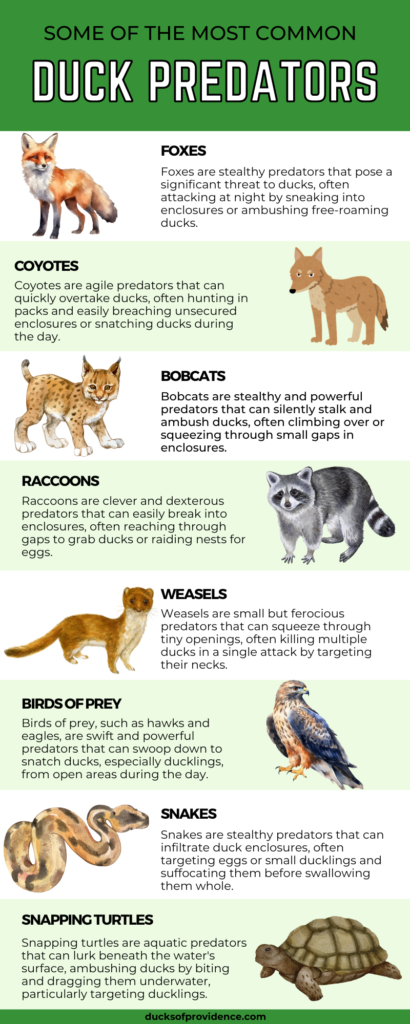
Want to learn more about predator-proofing your duck run and coop? Read more in the following blog posts:



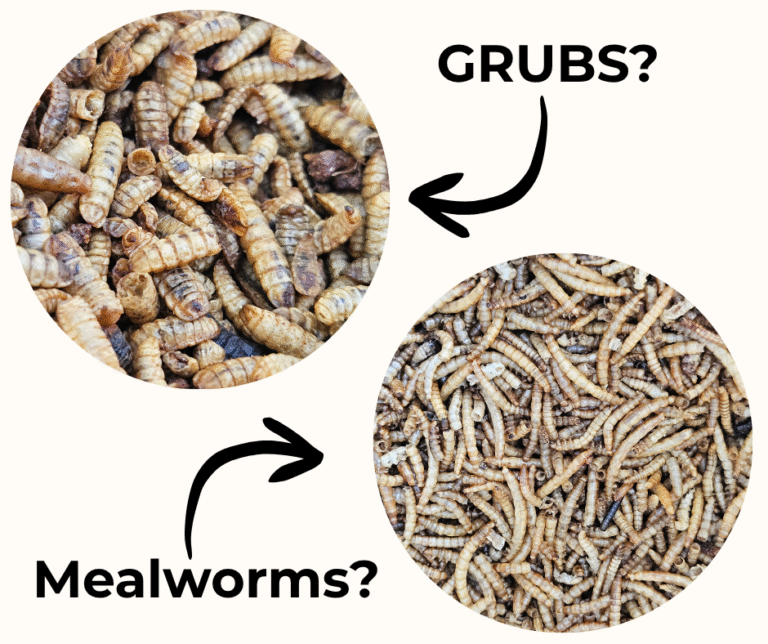
Large softshell turtles will eat ducklings and attack full grown ducks ,also great blue herons and big egrets will also eat ducklings
Thanks for sharing this with us!
What an informative post! I had no idea there were so many predators that target ducks. It’s interesting to learn about both the common ones like foxes and the less obvious threats like certain birds of prey. This definitely gives me a new perspective on wildlife interactions. Thanks for sharing!
This is such an informative post! I had no idea that owls were such significant predators of ducks. It’s fascinating to learn about both the common and not-so-common threats they face. Thanks for shedding light on this crucial aspect of wildlife!
This post was incredibly informative! I had no idea some of the lesser-known predators like raccoons and herons posed such a threat to ducks. It’s a real eye-opener about the challenges these birds face. Thank you for sharing!
Great article! It’s fascinating to learn about the various predators that ducks face. I had no idea that some of the lesser-known ones could be such a threat. Thanks for sharing these insights!
Great article! I had no idea that some of these predators were such a threat to ducks. The section on snakes was particularly eye-opening. It’s fascinating to learn about the various challenges these birds face in the wild. Looking forward to more posts like this!
This post was so informative! I had no idea there were so many predators that target ducks. The section about the effects of habitat loss on their survival really hit home for me. I’ll definitely be more mindful about protecting their environments. Thanks for shedding light on this important topic!
This was such an informative read! I had no idea there were so many predators that target ducks. The information about the less common ones was particularly eye-opening. I’ll definitely be more aware when I see ducks in the wild now. Thanks for sharing!
Great article! I had no idea that some predators of ducks were so uncommon. The section about that specific type of hawk was particularly intriguing. It really opened my eyes to the challenges ducks face beyond the usual culprits like foxes and raccoons. Thanks for sharing!
Great insights on duck predators! I never knew that certain birds of prey could be such a threat. It’s fascinating and a bit alarming to learn about the lesser-known predators too. Thanks for sharing this information!
This post was so informative! I never realized how many different predators ducks have to contend with. The section on the less common predators was especially eye-opening. It’s fascinating to learn how different environments can influence the types of threats ducks face. Thanks for sharing such thorough research!
This was such an interesting read! I had no idea that some predators were so uncommon. I thought I knew all the threats to ducks, but learning about those less obvious ones was eye-opening. Thanks for sharing these insightful details!
Great insights on duck predators! I had no idea some of these were threats. The section on unexpected predators was especially eye-opening. Thanks for sharing such valuable information!
This was such an informative post! I never realized how many different predators ducks face. The insights on both common and not-so-common threats were eye-opening. It’s so important to protect their habitats, especially with some of those unexpected predators. Thanks for sharing!